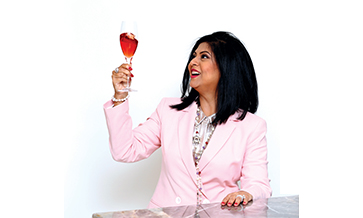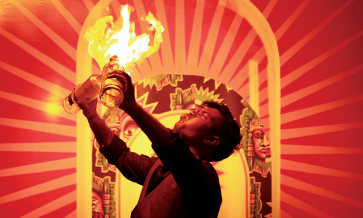The International Wines & Spirits Record’s Drinks Market Analysis indicates that Indian single malts soared 144% in 2021-22, beating the 32% growth in Scotch – no small feat, given that India has become the world’s largest export market for Scotch whisky. This trend shows no sign of dying out: IWSR again expects that, for the period until 2027, consumption of Indian single malts is set to grow 13% year-on-year compared to Scotch at 8%. Vikram Achanta takes a deep dive to record the back story.
Within the space of a week in December, I was present at the launch of not one, but two Indian single malts. The first was the launch of Longitude 77° from Pernod Ricard, and the second a small and intimate tasting in Mumbai of Crazy Cock, from Dahanu-based South Seas Distilleries.
The former is named after the longitude that passes through India at 77° East, and the other inspired by “a different kind of crazy”. Different inspirations for their branding, but both symptomatic of the growing ambition of single malts from India, one launched by the world’s second-largest adult spirits company and the other by a 40-year-old supplier of malt spirits, now forward integrating.
If anything, Indian single malt as a category has been held back by its availability. Surprised by the tremendous appetite of consumers, domestic and multinational distillers are now frantically expanding capacities. We are in a segment of the industry that is still very nascent and barely a decade old. Considering this, the strides that have been made are tremendous.
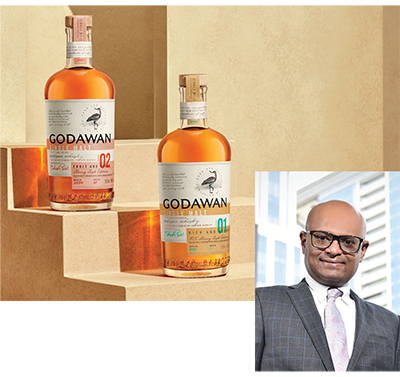
Diageo’s Godavan (L). Vikram Damodaran (R) says Indian single malts are unique and a true testimony to the geographical and topographical diversity of India.
Different brew
There are a few key factors that help distinguish Indian single malt from its counterpart in Scotland, or even whiskies closer home from Taiwan and Japan. The first, and possibly most crucial, is the genotype of barley that is used.
Indian single malt uses 6-row (of kernels) barley as compared to the Scottish 2-row barley. The 6-row barley is low on starch, and contains more proteins, nitrogen and husk, with the yeast having to work harder to convert the sugars and, therefore, also yielding 25% less alcohol than the 2-row barley.
The use of the 6-row barley also directly contributes to a bolder flavour profile for Indian single malt as compared to the typical floral and lighter profiles of the Scottish malts.
Vikram Damodaran, Chief Innovation Officer at Diageo India and Co-Founder of Diageo India Craft Spirits says, “Overall, 6-row barley is a mine of flavours. When processed appropriately it can deliver a sensory experience that is far differentiated and much more nuanced, compared to what is usually accepted as the norm.”
Shrikant Hajare of Ugar single malt adds that the use of the sun-drying process in India also adds a unique earthy depth to the malts. The only malt that is imported typically is the peated barley malt, for smokier expressions of whiskey.
In contrast the Taiwanese and Japanese single malt industries are largely built on imports of Scottish 2-row barley.
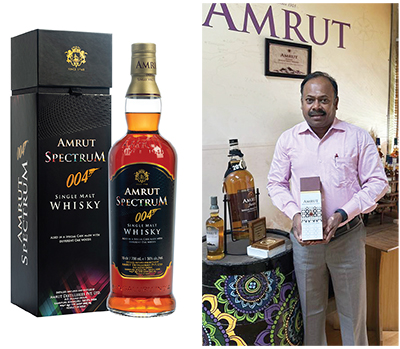
Amrut’s Spectrum 004 (L) was matured in a cask that had equal staves from French limousine oak, American oak, ex-PX sherry and ex-Oloroso sherry casks. It’s Head Distiller, Ashok Chokalingam (R), has his signature on the company’s latest single malt release, Amrut Distiller’s Reserve.
Greedy angels
A critical aspect in the maturation value chain is temperature. The high temperatures in India result in a faster and more intense maturation, again contributing to unique flavour characteristics.
Siddhartha Sharma, Founder of Piccadily Distilleries, makers of Indri says, “The increased temperature promotes a more intense interaction between the spirit and the barrel, extracting flavours and compounds at a faster rate.” Shrikant adds, “We can directly attribute the quicker emergence of oaky, nutty and caramel notes to these high temperatures.”
Indian distillers, therefore, also need to manage the maturation process with utmost care to avoid “over-aging” of the liquid. The flip side of the higher temperatures is that the evaporation loss (commonly referred to as the Angel’s share) is typically around 7-12% a year, as compared to 2-3% in Scotland.
Using tea as an analogy, Heemanshu Ashar, Head of Marketing for Paul John single malts says, “Indian single malts are the ‘hot brew’ of whiskey whereas Scotch is the ‘cold brew’.”
Vikram adds that the distilleries spread across the length and breadth of India, all have their own distinct design for their pot stills and this also contributes to the signature style of Indian single malts.
Ashok Chokalingam, Head of Distilling at Amrut, says: “Each of Indian single malts can be said to be unique and inimitable. For example, the character of Amrut’s single malts is determined by Bengaluru’s low humidity and high temperature micro-climate.”
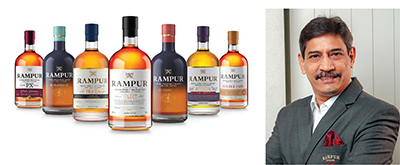
Radico Khaitan’s popular Rampus single malt whiskies (L) come in three other expressions: Trigun, Jigalbandi and Asava. According to Sanjeev Banda (R), today exports account for over 75% of Rampur sales.
GI or no?
Given the unique characteristics described, the question does arise therefore if we can (and should) have a unique geographical indication (GI) for Indian single malt.
There are two separate questions here, one being a formal definition of Indian single malt that has now been formulated by the Food Safety and Standards Authority of India, endorsed by the Confederation of Indian Alcoholic Beverage Companies. It will come into force in March 2024.
Establishing a GI for Indian single malt is more complex. Industry players are generally supportive of the move to GI, except that, as Heemanshu points out, Indian single malt is made in at least five states of India, with 6-row barley sourced from multiple states in North India.
A GI tag is always linked to a unique produce from a strictly defined area, such as tea from Darjeeling or sparkling wine from the Champagne region.
There is an uptake of cultivation of 2-row barley, and manufacturers such as Amrut Distilleries are looking to start using this for several of their expressions in the coming years. That may further complicate the move to GI-tagging.
Brand image
The movement to define what exactly is an Indian single malt is a welcome one and will help in instilling trust and confidence in products thus labelled. Many in the industry in India strongly believe that Indian single malt has already come of age in terms of quality, consistency, provenance, positioning and desire.
“What is needed now is deep story-telling, that romances India and its agricultural diversity, its rich history with distillation, the geographic nuances and the universe of flavour we are blessed with,” says Vikram of Godawan.
Kartik Mohindra, CMO and Head of Global Business Development at Pernod Ricard India, owner of Longitude 77°, says it’s “only a matter of time before India is truly put on the global map”.
Ashok makes a telling point when he says our spirit is truly Indian: “Most of us in the single malt space source our material, pot stills and processes in a uniquely Indian way.”
Halo effect
A testament to the brand image and reputation of Indian single malts is its immense popularity overseas. New brands like Indri are already present in over 18 countries with 30% of their sales coming from international markets.
Amrut sold 120,000 (9-litre) cases of its single malts portfolio in 2022-23, clocking approximately 40% in exports. Sanjeev Banga, President for International Business at Radico Khaitan (Rampur) says exports already account for 75% of the company’s single malt sales.
Another factor that has boosted Indian brands is international awards and recognition. Right from Jim Murray anointing Amrut Fusion as the 3rd-best whiskey in the world in 2010, to Paul John winning 305 international medals across its portfolio so far, Indian single malts have been winning a bucketful of awards around the globe.
Most recently the Indri Diwali Edition 2023 won a ‘Best in Show’ and Double Gold award at the Whiskies of the World award. Along with the critical acclaim they bring, the accolades also help drive a bidding war for a lot of expressions, especially the limited editions.
Apart from potentially higher levels of profitability overseas, what also benefits Indian single malts is that their burgeoning international reputation has a welcome halo effect back in India, and a strong consumer pull.
According to Vaspar Chinoy of South Seas Distilleries, “It helps amplify the quality of the brand, as an overall part of the marketing strategy. But choosing the right competitions is very critical.”
The next step towards brand building is the move to create their brand homes: Paul John set up a visitor centre at the distillery in Goa; Rampur has a tastefully designed space; and Piccadily is well on its way to creating a brand home for Indri with a three-hole golf course!
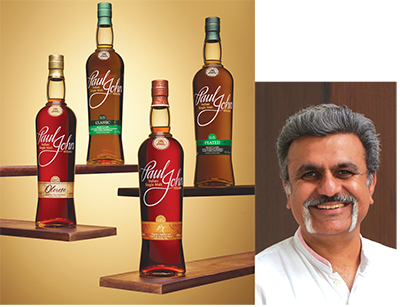
John Distilleries is Asia’s most awarded producer across its portfolio, with 305 international medals. Heemanshu Ashar (R) says the company takes a focussed, strategic approach to build the Indian single malt category.
The enablers
Without a doubt the consumer has been one of the biggest reasons behind the success of Indian single malts. With a growing appreciation for quality whiskey and increasing confidence and pride in buying Indian, they also flock to Indian brands.
A flurry of releases from established brands such as John and Amrut distilleries are ensuring that the whiskey enthusiast is constantly spoiled for choice. The emergence of formal communities such as the Single Malt Amateur Club has also helped considerably.
Such communities organise visits for their members to the brand homes, gain access to exclusive tasting sessions, and occasionally the access to a single cask whiskey made exclusively for the club.
Examples are the several single cask editions for SMAC from John and Amrut distilleries, apart from similar projects with independent bottlers around the world.
The growing sophistication and size of liquor retail shops also ensures sufficient shelf space for local brands. There is also now a wide selection of brands available in duty-free shops across India, giving visitors to India sufficient choice to stuff their bags.
One would now hope that high-end bars and restaurants, especially those in star hotels, give increasing share of shelf to Indian single malts – unlike their hitherto step-motherly treatment of Indian wine!
Kartik (Pernod) says, “There is a fair amount of traction with respect to the category, given that a lot of the top-end fine-dine and luxury tourism establishments cater to the Indian expat community who seek such experiences and products.”
Overseas it is quite common now to see Indian single malts as a part of the ‘World Whiskey’ section of menus. In India too, I definitely feel that there is an opportunity for top hotels and bars to build a strong Indian single malt menu – perhaps even have bars dedicated to this!
But there are constraints too. Ashok from Amrut says the biggest challenge in the on-trade promotion is the inability of Indian brands to give a consistent supply of single malts. “In India my challenge is availability of stocks: we sell out so fast that we are not easily visible!” he says.
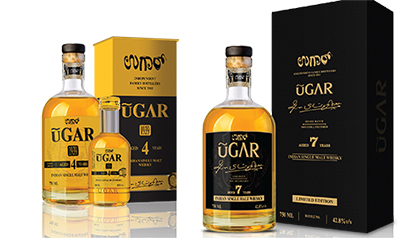
Ugar Sugar Works’ Ugar 4-YO and Ugar 7-YO are both bottled at 42.8% ABV.
Threat or opportunity?
The long awaited Free Trade Agreement between the UK and India may well come about in 2024. If it does, it could represent both a threat as well as an opportunity for Indian brands.
Ashok (Amrut) is of the opinion that Indian whiskey producers should have a level playing field, and that Indian whiskies should be allowed to be sold in the UK and European Union, even if they are matured for only 2 years, as opposed to the current minimum 3-year clause.
Siddhartha (Piccadily) stresses that it is important to ensure that the cost of products sold in India should not be less than the sale price of the product in the country of origin.
My sense is that Indian brand owners are quite confident of their ability to compete with international brands, even if duties come down. The potential impact, as one pointed out, could be on vatted malt spirit (VMS) supplied to Indian blends as reduced prices for Scottish VMS may tip the scales in the UK’s favour.
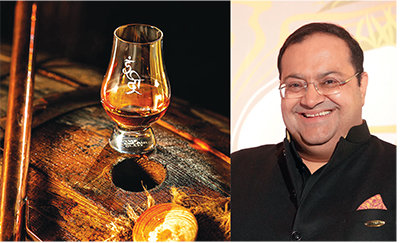
Picadilly Distilleries’ award-winning Indri single malt has recorded a 67-fold growth in sales since its launch in 2021. Founder Siddhartha Sharma says the brand has a strong foothold in 18 countries, and 30% of the company’s current revenues come from exports.
Talent war
The explosion in single malt brands and tremendous increases in production capacity are definitely putting stress on one crucial aspect: qualified manpower in the form of master distillers and blenders, production and marketing.
Vikram (Diageo) believes that industry forums and communities that help project and exemplify the work of our top distillers and blenders should grow multi-fold. This will give youngsters of a technical bent of mind a “clear opportunity to build a legacy of their own”.
Amrut’s Ashok is encouraged by Indian enrolment into global institutes like Edinburgh’s Heriot-Watt and the Institute of Blending and Distilling, and their return to India. He also sees talent coming from institutes like the Vasantdada Sugar Institute in Pune and graduates of the Wine and Spirits Education Trust programmes.
Perhaps echoing Vikram’s words above, it is also important to start seeing the names of top Indian blenders and distillers on the bottles they create, and their sign visible there. Amrut’s latest release, the Master Distiller’s Reserve, has Ashok’s signature on each bottle.
Paul John’s Head Distiller, Michael D’Souza, is very conspicuous as the face of the brand, which is named after the company’s founder itself. Kunal Madan, Global Brand Head of Rampur says, “The experimentation and innovation undertaken by the Master Distillers need to be recognised and acknowledged.”
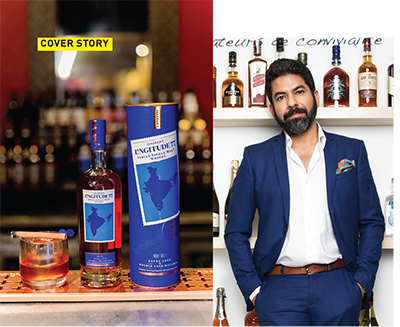
Longitude 77° has been launched in Maharashtra, Haryana, Chandigarh, Rajasthan, Uttar Pradesh and Delhi Duty-Free. Kartik Mohindra (R) says the brand is set to expand its footprint globally, starting with Dubai.
What next?
Indian single malts, however, do make full use of casks available from the West, both for maturing and finishing, from the basic ex-bourbon to Oloroso and PX sherry and even Port pipes.
Amrut went one step further by finishing Spectrum 004 in a cask that had equal staves from four different types: French limousine oak, American oak, ex-PX sherry and ex-Oloroso sherry casks!
Sanjeev Banga of Rampur is also clear that innovation is the way ahead for Indian single malts, and that “we need to showcase our Indianness to the world through our single malts”.
There is near unanimity that there needs to be a body that exclusively represents the cause of Indian single malt brands that can help champion its case and build the category even further.
Heemanshu sums it up: “When we participate in international exhibitions and events, we try to book stalls in close proximity, to be seen as a category. Of course, we need to do more in the future.”
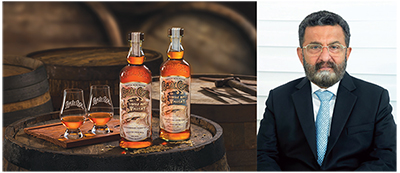
South Seas Distilleries recently launched its small-batch Crazy Cock single malt in two expressions (L). Its Founder, Viraf Chinoy, feels it is important for the on-trade to buy in to Indian brands.











